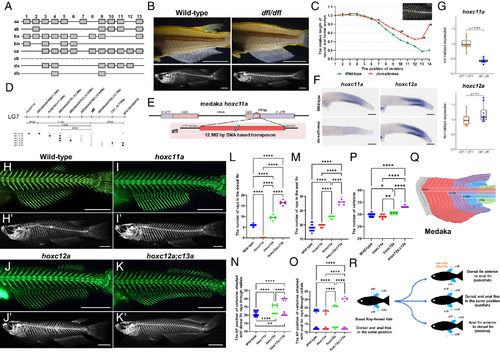Fig. 4
- ID
- ZDB-FIG-240624-11
- Publication
- Adachi et al., 2024 - Teleost Hox code defines regional identities competent for the formation of dorsal and anal fins
- Other Figures
- All Figure Page
- Back to All Figure Page
|
hox genes responsible for the formation of the anterior dorsal fin are not orthologous between zebrafish and medaka. (A) Medaka possess 46 hox genes in seven hox clusters. (B) The posterior body (Top) and whole skeletal structures by micro-CT scanning (Bottom) of WT (n = 3) and dfl (n = 3) adult fish. (Scale bar, 3 mm.) 3D movies are available with Movies S9 and S10. (C) Relative length of neural and hemal arches between WT and dfl medaka. The measurement is briefly shown in the Upper Right diagram. For more information, see Materials and Methods. The vertebra to which the anteriormost ray of the anal fin was attached was defined as vertebra 1. Two-sample t test was performed with *P < 0.05. (D) Recombinant panel of the dfl mutants. dfl homozygotes are represented by white squares and heterozygotes by black squares. (E) Insertion of transposon-like element into hoxc11a 3′UTR. (F) Whole-mount in situ hybridization shows the expression patterns of hoxc11a and hoxc12a between WT and dfl mutants. (Scale bar, 100 μm.) (G) qPCR analysis of normalized expression of hoxc11a and hoxc12a mRNA between WT and dfl mutants. The Mann–Whitney U test was performed. (H–K) Calcein staining to visualize the skeletons of hox mutant juvenile medaka. (H’–K’) X-ray micro-CT scan images of adult medaka (n = 3 for each mutant). Genotyping of these mutants is shown in SI Appendix, Table S5. 3D movies are available with Movies S11–S13. (Scale bar, 3 mm.) (L and M) Comparison of the number of fin rays in the dorsal fin (L) and anal fin (M). (N and O) Comparison of the anterior and posterior ends of the vertebrae attached to the fin rays of the dorsal fin (N) or anal fin (O) through the radials. The anterior end of the vertebra is marked with a circle, and the posterior end is marked with a rectangle. (P) Comparison of the number of vertebrae. Statistical analysis was performed using data collected from six calcein-stained juvenile medaka. The Tukey–Kramer test was performed with *P < 0.05, **P < 0.01, ***P < 0.001, and ****P < 0.0001. (Q) Models of how multiple hox genes define the formation-competent regions of the dorsal and anal fins in medaka in the posterior body. (R) Hypothesis of the evolutionary scenario in the Hox patterning system of the dorsal and anal fins in the ray-finned fishes. |

